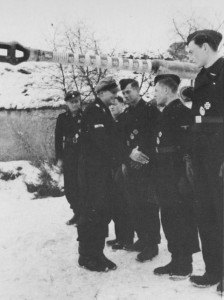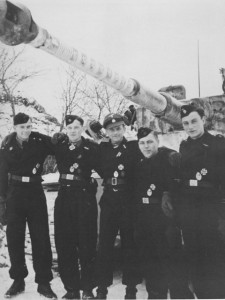By the time Michael Wittmann had arrived on the Eastern Front for what was the third and final time, the situation had gone from bad to worse for the German leadership. The Ukrainian city of Khar’kov had been retaken by the Soviets, and the Red Army was now storming relentlessly through the Ukraine and on towards Germany itself.
At the end of October 1943 the Tigers of the Leibstandarte SS Adolf Hitler were loaded up on four trains to be transported to the front, a ten-day journey that would take them north into Austria and then east across Poland to the western Ukraine. The new arrivals had little time to organise themselves effectively once they had reached their assembly point, for no sooner had the Panzers rolled off the train they would quite literally land right in the middle of the battle. The focal point was the town of Brusilov, located between the city of Zhytomyr and the Ukrainian capital of Kyiv, which had fallen into Red Army hands less than a week earlier.
Brusilov: Straight into the fire
Right from the start, SS-Hauptsturmführer Kling’s Panzers were at a disadvantage. Their arrival right in the thick of the Soviet advance had caught them completely off guard; half of the Tigers that had arrived at the front were unserviceable and in need of repair. To compound matters, two of the Panzers had to be abandoned following an incident with a enemy tank ditch. With the enemy threatening to overrun the German lines, the two stricken vehicles had to be destroyed where they both stood.
With two precious Tigers being lost without firing a shot in anger at the enemy, it was not the greatest start to what was always going to be another difficult campaign.
On 13th November 1943, in the face of overwhelming odds, Wittmann and his crew were able to destroy more than two dozen Russian vehicles and anti-tank guns. Yet despite this show of skill and bravery, it was becoming increasingly obvious that this was not going to be enough to deal with the relentless flow of Soviet armour. For every one Michael Wittmann, there were at least three Red Army tank commanders.
The constant skirmishes also meant that the overworked Tigers were even more prone to mechanical failure, and on 20th November Wittmann himself had to deal with a faulty vehicle. Given that the Tigers were so precious, emergency repairs to disabled or broken down vehicles would often take place deep inside enemy territory. It was a game of high risk.
21st November saw plenty of drama, with Wittmann deciding to take command of his Tiger in spite of his suffering from a high temperature. Despite being unable to function at one hundred percent, the man who was quickly becoming a talisman for his colleagues knew that he had to be seen to be out in the thick of the action – nothing else would do. His gunner that day, SS-Sturmmann Bobby Warmbrunn, destroyed a total of thirteen T34s and seven of the hated anti-tank guns.
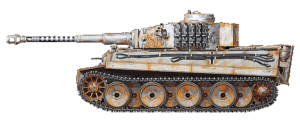
According to other reports, Wittmann also suffered a close scrape following a man to man encounter with the crew of an enemy vehicle: after taking out two of the three Russians, the third managed to get a shot in, the bullet tearing through Wittmann’s chin. In spite of this, the adrenalin was enough to see the brave Panzer commander ignore the pain and get an accurate burst at the third Russian crewman with his MP-40.
The skirmishes around Brusilov, Radomysl and Zhytomyr would last the best part of a month up until the last week of November 1943. Despite a number of small-scale German successes, the Soviets would retain their overall advantage and continue their push westwards. The presence of commanders like Wittmann continued to make a difference, but with so few of them up against what seemed like a never ending stream of enemy armour, it was increasingly difficult to maintain let alone build morale. Experience could only offer so much against the weight of sheer numbers.
Small punches, big hammer blows
The following months were to see the now familiar advance of generals mud and winter, although not before the Germans were celebrating an audacious advance during the first two weeks of December orchestrated by the legendary SS-Sturmbannführer Jochen Peiper – whose formation had charged some twenty-five miles near Zhytomyr, smashing a hole in the enemy’s defences and capturing thousands of enemy prisoners and numerous pieces of artillery.
These successes were little more than small punches in response to the massive hammer blows being inflicted across the entire front by the enemy, but these stories continued to radiate through the propaganda outlets back in Germany. The Russian advance was relentless, but the heroic soldiers of the Waffen-SS were still out there, stoutly defending the Fatherland and throwing everything they could against a pitiless foe in an even more hostile environment.
During the first day of this action – which saw Peiper awarded the Oak Leaves to his Knight’s Cross – Michael Wittmann’s Tiger destroyed three T34s and an anti-tank battery near the town of Torczyn in the Volhynia, some three hundred kilometres east of the river Bug and the Polish-Ukrainian border. The latter action was particularly noteworthy; in the words of SS-Sturmmann Walter Lau, Wittmann had “blasted the enemy with furious barrages of gunfire, crashed through the position and positioned himself astride the enemy’s supply road like a wolf in a herd of sheep. He placed his fiery mark on the road, smashing long lines of Soviet vehicles into junk and causing mass confusion among the Soviets”.
Three days later on 9th December Wittmann’s Tiger, accompanied by two other vehicles, was ambushed by twenty Soviet tanks in the vicinity of the town of Meshiritschka. Although initially taken by surprise, the Tigers quickly turned the tables on the enemy, with Wittmann’s gunner Bobby Woll destroying six of the T34s with the powerful 88mm gun. The success of these small-scale actions led to a new surge of confidence among the men of the Tiger Company as the year came to an end, but there was no respite.
During the battles around Berdichev at the end of December and yet another injury sustained by the unfortunate Heinz Kling, Wittmann was again assigned to the post of company commander; on 2nd January 1944, he had twelve Tigers under his command. The turn of the year was also to witness emergence of a more fearsome Soviet weapon, the T34/85 – a regenerated T34 now armed with a massive 85mm main gun that came close to equalling the firepower of the German KwK 88.
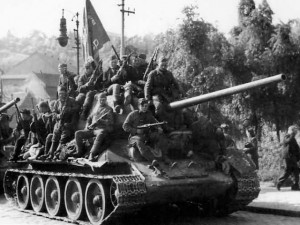
The next notable action undertaken by the company’s new commander took place during the night of 7th/8th January, in and around the town of Sherepki. Engaging the enemy head-on in his own inimitable style, Wittmann and his crew knocked out a trio of enemy tanks and an anti-tank gun, with gunner Balthasar Woll proving himself to be a master of his craft once more. The Sherepki action was to prove to be the catalyst for what turned out to be a successful defensive action by the Leibstandarte, with a total of thirty-three T34s and seven enemy assault guns destroyed.
The following day, Wittmann once again spearheaded the defensive counterattack, claiming a further six victims as he almost single-handedly routed the enemy and halted their attack. Having now claimed an astonishing total of sixty-six victims in less than six months, the tales of Wittmann’s exploits had finally reached ears beyond those of his company.
Wittmann finally joins the élite
Following the two intense days of combat on 8th and 9th January 1944 which had seen the destruction of nine enemy Panzers and an anti-tank gun, on 10th January Wittmann was finally recommended by divisional commander SS-Oberführer Theodor “Teddi” Wisch for the prestigious Ritterkreuz, the Knight’s Cross of the Iron Cross. The official recommendation read as follows:
SS-Untersturmführer Wittmann, platoon commander 13.(s)/SS-Pz.Rgt. 1 LSSAH, has himself destroyed 56 tanks in the period July 1943 to 7.1.1944, including several KVI, KVII, General “Sherman”, the rest were T34s.
During a penetration near Sherepki by a Russian tank brigade on 8.1.1944 he and his platoon succeeded in stopping the attack and he himself knocked out 3 T34s and 1 assault gun.
On 9.1.1944 he destroyed another 6 T34s during a penetration by enemy tanks and raised his total of tanks destroyed to 66. He once again demonstrated exceptional bravery in meeting and smashing the Russian tank attack.
Signed Wisch, SS-Oberführer and Divisional Commander
Between his being recommended for the Knight’s Cross on 10th January and receiving the award four days later, SS-Untersturmführer Wittmann embarked on a what can only be described as a victory celebration of destruction. Over this short period, Wittmann’s Tiger had knocked out an astonishing twenty-two enemy tanks, which took his total to eighty-eight enemy tanks destroyed. Over the 12th and 13th January alone, Wittmann and his crew knocked out a phenomenal sixteen T34s and three anti-tank guns.
In what was a highly successful series of missions, the only moment of bad luck that took place was when Wittmann lost a front tooth in a freak accident in a Schwimmwagen – though other sources have stated that he had lost the tooth by hitting his head against the cupola of his Tiger after it had driven over an obstacle.
The story was not all about Wittmann, however: a successful Tiger not only needed a talented commander but also a well-knit, disciplined and skillful crew. Wittmann himself would continually acknowledge that his outstanding record could never have been achieved without his gunner, the crackshot Saarlander Balthasar “Bobby” Woll, who during his short career as a Tiger gunner had destroyed a total of eighty enemy tanks. Following the actions of 12th and 13th January Woll was also nominated for the Knight’s Cross. Both Wittmann and Woll were awarded their Knight’s Crosses on 14th January, by divisional commander “Teddi” Wisch.
By this time, Wittmann’s spectactular tank-busting exploits on the Eastern Front had become headline news in Germany, and by the end of the month he had claimed his 100th kill. On 30th January, he was sent a telegram from Hitler’s headquarters, confirming the award of the Oakleaves to the Knight’s Cross:
In gratitude for your heroic action in the battle for the future of our countrymen, I award you the Oakleaves to the Knight’s Cross of the Iron Cross as the 380th soldier of the German Wehrmacht.
Adolf Hitler
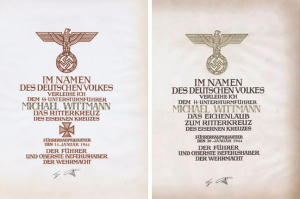
Wittmann would receive his Oakleaves personally from Hitler on 2nd February 1944 at the Wolfsschanze near the East Prussian town of Rastenburg, and his receiving the two awards within the space of just over a fortnight would put him in some very special company. Hitherto unknown, the twenty-nine year old Leibstandarte Panzer commander was making the headlines for his heroics on the Ostfront.
In addition to his being awarded the coveted Oakleaves, Wittmann was also promoted to the rank of SS-Obersturmführer, a promotion which had been long in coming. On 15th February, following the hospitalisation of Heinz Kling, the twenty-nine year old Bavarian was appointed commander of 2. Kompanie of the schwere (heavy) SS Panzer Abteilung 101.
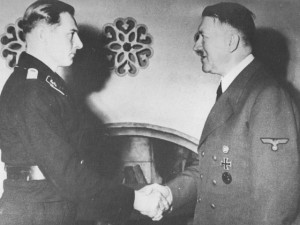
By this time Wittmann had become the most successful tank commander of the war, a hero worshipped by millions of his countrymen and women – a living the embodiment of the “last hope”. This was more than true for the 35,000 or so embattled troops that had found themselves surrounded in the Tscherkassy pocket, only to be eventually evacuated after an audacious attack by the LSSAH and Das Reich, during which Wittmann would claim another nine victims.
This was the last Michael Wittmann would see of the Russian Front, with the LSSAH being evacuated for rest and refit in Belgium. In the struggle that was to follow, the SS-Obersturmführer would be elevated from being a highly respected soldier and trusted comrade to a legend in his own right.

